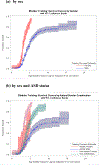Toilet Training in Fragile X Syndrome
- PMID: 31593026
- PMCID: PMC6878164
- DOI: 10.1097/DBP.0000000000000735
Toilet Training in Fragile X Syndrome
Abstract
Objective: To characterize bladder and bowel toileting skill acquisition in children with fragile X syndrome and to identify associated demographic, behavioral, and clinical factors.
Methods: Using baseline data from the Fragile X Online Registry With Accessible Research Database (FORWARD), bivariate analyses and logistic regression models were used to identify differences between subjects who were and were not bowel and/or bladder trained by the age of 10 years. Cox proportional hazard models were used to assess the rate of completion of toilet training (TT) as a function of sex and autism spectrum disorder (ASD) diagnosis.
Results: In bivariate analyses, male sex, lower language level, inability to write one's name, more impaired intellectual level, ASD, and more severe behavioral deficits all predicted lack of bladder training (n = 313, p < 0.001) and bowel training (n = 300, p = 0.0004-0.0001) by the age of 10 years. In logistic regression models, lower level of language acquisition (p < 0.001) and higher Aberrant Behavior Checklist Irritability scores (p < 0.04) were associated with lower odds of bladder training by the age of 10 years. Lower level of language acquisition (p < 0.001) and ASD (p < 0.025) were associated with lower odds of bowel training by the age of 10 years. For both bladder and bowel training, Cox proportional hazard models indicated that delayed training was associated with male sex, lower levels of language acquisition, and ASD for both bladder training (n = 486; p < 0.001) and bowel training (n = 472; p < 0.001).
Conclusion: These findings emphasize the importance of both slower language development and ASD diagnosis in predicting bowel and bladder training delays and can be used to develop and evaluate targeted approaches to TT based on sex, ASD diagnosis, and other clinical features identified in this study.
Conflict of interest statement
Disclosure Statement: None of the authors have any conflicts of interest relevant to this manuscript.
Figures
References
-
- Sells-Love D, Rinaldi LM, McLaughlin TF. Toilet training an adolescent with severe mental retardation in the classroom: A case study. J Dev Phys Disabil. 2002;14(2):111–8. doi:10.1023/a:1015272212804 - DOI



